Schneider Electric Bundle
How Does Schneider Electric Power the Future?
In a world demanding sustainable and efficient energy solutions, understanding industry leaders is crucial. Schneider Electric, a €36 billion powerhouse, is at the forefront of digital automation and energy management. This deep dive explores how this global giant operates, creating value across diverse sectors.
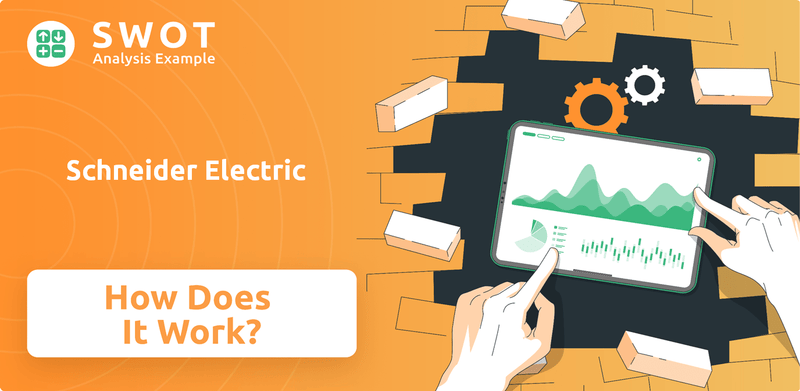
This exploration of the Schneider Electric SWOT Analysis will reveal the inner workings of the Schneider Electric company, from its innovative EcoStruxure architecture to its strategic focus on electrification and digital transformation. Discover how Schneider Electric products and services are shaping industries and driving sustainability initiatives. Learn about the Schneider Electric business model and its impact on global markets, including its energy management solutions and automation products, and what industries does Schneider Electric serve.
What Are the Key Operations Driving Schneider Electric’s Success?
The core operations of the Schneider Electric company revolve around providing integrated solutions for energy management and industrial automation. Their business model focuses on offering a comprehensive suite of products, services, and software to enhance efficiency, reliability, and sustainability for their clients. Key areas of focus include power distribution, secure power, automation and control, and building management systems.
The Schneider Electric business caters to various customer segments, including commercial and residential buildings, data centers, industrial manufacturers, and infrastructure providers. Their operational processes are highly integrated, encompassing research and development, advanced manufacturing, and global sourcing. This integrated approach ensures they can deliver a diverse portfolio of solutions efficiently to meet the specific needs of different markets.
The value proposition of Schneider Electric lies in its ability to improve operational performance and sustainability for its customers. Their EcoStruxure platform, an open and interoperable system, integrates operational technology (OT) with information technology (IT). This integration provides actionable insights and optimizes performance across various domains, from smart grid solutions to industrial automation systems. The company has a robust global supply chain, extensive partnerships, and a broad network of distributors to reach its diverse customer base.
The company's core offerings are centered on energy management and industrial automation. These include power distribution, secure power solutions, automation and control systems, and building management systems. These products and services are designed to improve energy efficiency and operational reliability.
Their primary customer segments include commercial and residential buildings, data centers and networks, industrial and machine manufacturers, and infrastructure providers. They tailor solutions to meet the specific needs of each sector, ensuring optimal performance and efficiency. This diversification helps them maintain a strong market presence.
Operational processes are highly integrated, encompassing research and development, advanced manufacturing, global sourcing, and sophisticated logistics. This integration ensures efficient delivery of their diverse portfolio. The company's focus on operational excellence is key to its success.
The value proposition is rooted in enhancing efficiency, reliability, and sustainability for its customers. The EcoStruxure platform enables the integration of operational technology with information technology. This approach delivers actionable insights and optimizes performance across various domains.
Schneider Electric differentiates itself by combining hardware, software, and services into integrated solutions. This holistic approach provides significant customer benefits, such as reduced energy consumption and improved operational uptime. Their comprehensive approach allows them to offer tailored solutions to meet specific market needs.
- The company’s global presence includes operations in over 100 countries.
- They have a strong focus on sustainability, with goals to reduce their customers' carbon emissions.
- Schneider Electric invests heavily in R&D, with approximately 5% of revenue allocated annually.
- Their EcoStruxure platform supports over 450,000 installations worldwide.
For a deeper dive into how Schneider Electric approaches the market, you can explore the Marketing Strategy of Schneider Electric. This provides valuable insights into how the company positions itself and reaches its target audience.
Schneider Electric SWOT Analysis
- Complete SWOT Breakdown
- Fully Customizable
- Editable in Excel & Word
- Professional Formatting
- Investor-Ready Format
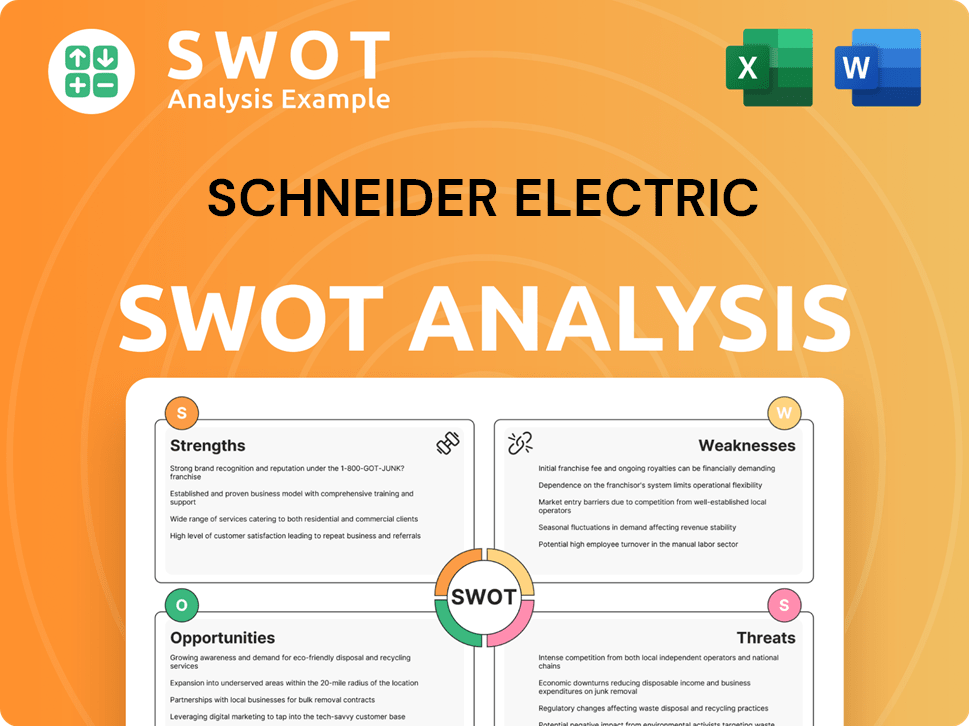
How Does Schneider Electric Make Money?
The Schneider Electric company generates revenue through multiple streams, primarily centered around its products, software, services, and comprehensive solutions. The company's diverse offerings cater to various sectors, with a significant focus on energy management and industrial automation.
In 2023, Schneider Electric reported a total revenue of approximately €36 billion. The Energy Management segment and the Industrial Automation segment were major contributors to this figure, indicating the breadth of the company's market presence and the effectiveness of its business model.
The Schneider Electric business employs several monetization strategies to maximize its revenue potential and maintain a strong market position.
Key monetization strategies for Schneider Electric include direct sales of equipment and components, recurring revenue from software subscriptions and service contracts, and project-based revenue from large-scale solution implementations. The company's approach reflects a strategic shift towards increasing recurring revenue, which provides more stability and fosters stronger customer relationships. This shift is in line with industry trends favoring subscription-based models.
- Direct Sales: Revenue generated from selling a wide range of Schneider Electric products, including electrical distribution equipment, industrial automation components, and building management systems.
- Recurring Revenue: Income from software subscriptions, service contracts, and maintenance agreements, offering long-term value and predictable cash flow.
- Project-Based Revenue: Earnings from implementing comprehensive Schneider Electric solutions, such as smart grid deployments, data center setups, and industrial automation projects.
- Tiered Pricing: Offering different pricing levels for software and services to accommodate various customer needs and budgets.
- Cross-selling and Bundling: Integrating various Schneider Electric services and products to offer comprehensive solutions, such as complete building management systems or end-to-end industrial automation suites.
Schneider Electric PESTLE Analysis
- Covers All 6 PESTLE Categories
- No Research Needed – Save Hours of Work
- Built by Experts, Trusted by Consultants
- Instant Download, Ready to Use
- 100% Editable, Fully Customizable
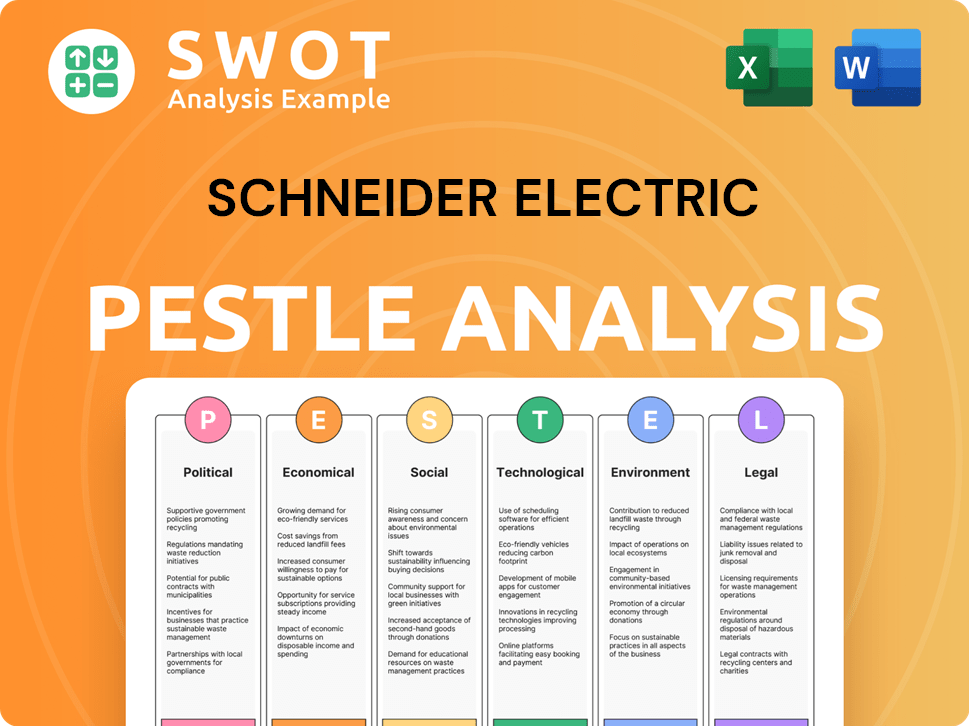
Which Strategic Decisions Have Shaped Schneider Electric’s Business Model?
The journey of the Schneider Electric company has been marked by significant milestones and strategic moves that have shaped its operations and financial performance. A pivotal strategic move has been its aggressive pursuit of digitalization and sustainability, exemplified by the continuous evolution of its EcoStruxure platform, which integrates IoT, cloud, analytics, and cybersecurity. This platform has been instrumental in expanding its market reach and reinforcing its technology leadership. The company has also engaged in strategic acquisitions, such as the acquisition of Aveva in 2023, which significantly bolstered its industrial software capabilities and expanded its digital twin and asset performance management offerings.
Operational challenges have included navigating global supply chain disruptions, particularly in recent years, which the company has addressed through diversified sourcing and localized production strategies. Regulatory hurdles, especially those related to energy efficiency and environmental standards, have also driven innovation, pushing Schneider Electric to develop more sustainable and compliant solutions. The company's competitive advantages are multifaceted, including its strong brand recognition, extensive global presence, and a vast portfolio of patented technologies. Its economies of scale allow for competitive pricing and efficient manufacturing. Furthermore, its robust ecosystem of partners, integrators, and developers creates network effects that reinforce its market position.
Schneider Electric continues to adapt to new trends, such as the increasing demand for renewable energy integration and the rise of edge computing, by investing heavily in R&D and fostering an agile innovation culture to maintain its competitive edge. Understanding the target market of Schneider Electric is crucial for appreciating its strategic positioning and growth trajectory.
Key milestones include the evolution of the EcoStruxure platform, which has been a cornerstone of its digital transformation strategy. The acquisition of Aveva in 2023 significantly enhanced its software capabilities. Continuous investments in R&D and innovation have led to advancements in energy management and automation.
Strategic moves include a strong focus on digitalization and sustainability, reflected in the EcoStruxure platform. The company has pursued strategic acquisitions to expand its capabilities, such as the acquisition of Aveva. It has also implemented diversified sourcing and localized production strategies to address supply chain challenges.
The company's competitive advantages include strong brand recognition and a global presence. It has a vast portfolio of patented technologies and economies of scale. Its robust ecosystem of partners reinforces its market position. The company is adapting to trends such as renewable energy integration and edge computing.
In 2024, Schneider Electric reported strong financial results, with revenues reaching approximately €36 billion. The company's investments in R&D accounted for around 5% of its revenue. The acquisition of Aveva contributed significantly to the growth in its industrial software segment.
Schneider Electric is committed to sustainability, with significant investments in renewable energy and energy efficiency solutions. The company's sustainability initiatives include reducing its carbon footprint and promoting circular economy practices. These efforts align with its mission to be a leader in energy management and automation.
- Developing energy-efficient products and solutions.
- Investing in renewable energy projects.
- Reducing its carbon emissions across its operations.
- Promoting circular economy practices.
Schneider Electric Business Model Canvas
- Complete 9-Block Business Model Canvas
- Effortlessly Communicate Your Business Strategy
- Investor-Ready BMC Format
- 100% Editable and Customizable
- Clear and Structured Layout
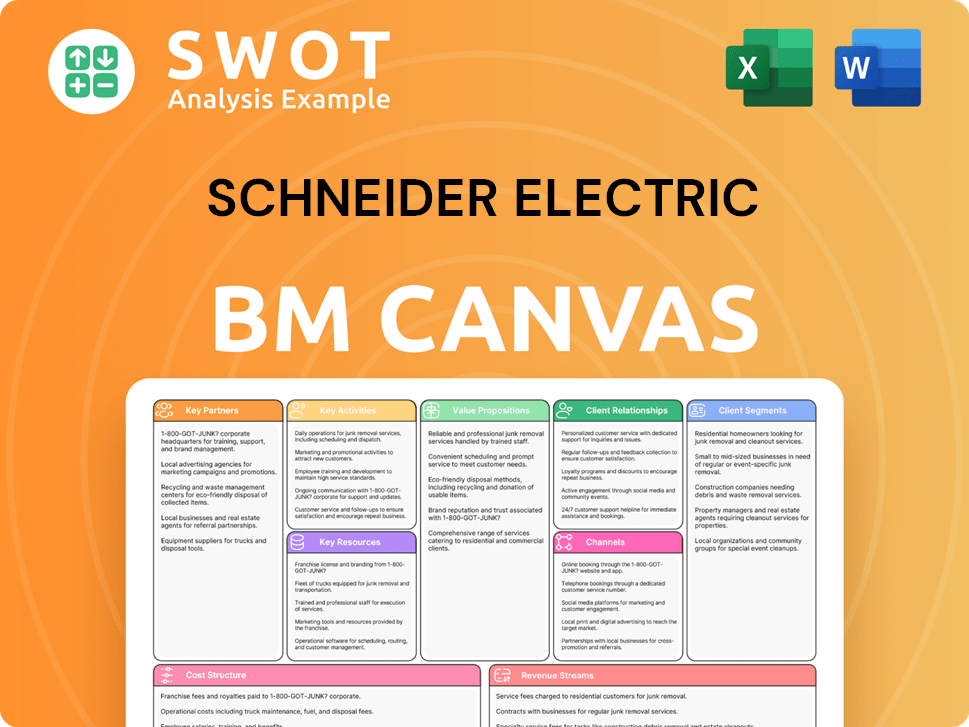
How Is Schneider Electric Positioning Itself for Continued Success?
The Schneider Electric company holds a significant position in the global energy management and industrial automation markets. It competes with industry leaders such as Siemens, ABB, and Eaton. The company benefits from strong customer loyalty, built on its reputation for reliability and innovation, and a comprehensive service offering. Its global operations span over 100 countries, providing a diverse revenue base and resilience against regional economic fluctuations.
Despite its strong market position, Schneider Electric faces various risks, including competition from new entrants, rapid technological advancements, and shifts in global regulations. Geopolitical uncertainties and economic downturns also pose challenges. However, Schneider Electric is actively mitigating these risks through strategic initiatives like investments in research and development, focusing on artificial intelligence, machine learning, and sustainable solutions. Leadership emphasizes organic growth, strategic partnerships, and targeted acquisitions to expand its market presence and technological capabilities.
Schneider Electric is a leader in energy management and industrial automation. It has a strong market share in power distribution and industrial control systems. The company's global presence and customer loyalty are key strengths.
Risks include competition, rapid tech changes, and regulatory shifts. Geopolitical and economic factors also pose challenges. The company actively mitigates these risks through strategic investments and partnerships.
Schneider Electric aims to drive digital transformation and energy efficiency. It focuses on sustainability and expanding its market presence. The company continues to innovate in areas like smart grid technology and data center solutions.
The company invests in R&D, focusing on AI and sustainable solutions. It emphasizes organic growth, strategic partnerships, and acquisitions. These initiatives support its long-term goals and market leadership.
The Schneider Electric company is committed to driving digital transformation and energy efficiency. It is also focused on capitalizing on the global demand for sustainability. This includes strategic investments and partnerships to expand its market reach and technological capabilities.
- The company's strategic focus includes expanding its digital offerings.
- It emphasizes sustainable solutions and smart grid technologies.
- Schneider Electric aims to sustain and expand profitability.
- The company is committed to organic growth and strategic acquisitions.
Schneider Electric Porter's Five Forces Analysis
- Covers All 5 Competitive Forces in Detail
- Structured for Consultants, Students, and Founders
- 100% Editable in Microsoft Word & Excel
- Instant Digital Download – Use Immediately
- Compatible with Mac & PC – Fully Unlocked
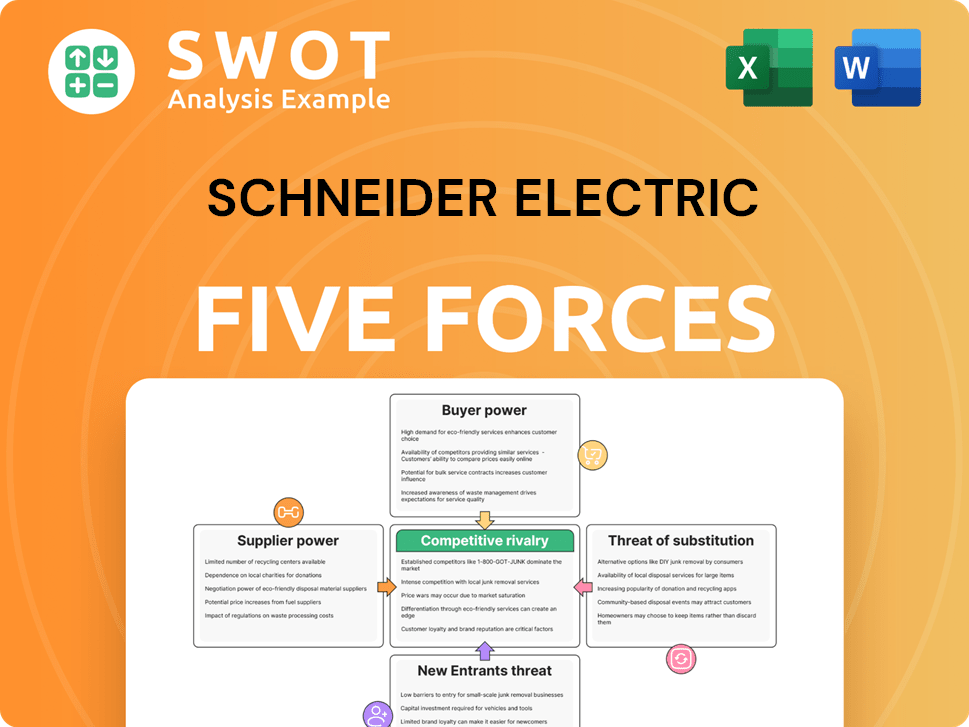
Related Blogs
- What are Mission Vision & Core Values of Schneider Electric Company?
- What is Competitive Landscape of Schneider Electric Company?
- What is Growth Strategy and Future Prospects of Schneider Electric Company?
- What is Sales and Marketing Strategy of Schneider Electric Company?
- What is Brief History of Schneider Electric Company?
- Who Owns Schneider Electric Company?
- What is Customer Demographics and Target Market of Schneider Electric Company?
Disclaimer
All information, articles, and product details provided on this website are for general informational and educational purposes only. We do not claim any ownership over, nor do we intend to infringe upon, any trademarks, copyrights, logos, brand names, or other intellectual property mentioned or depicted on this site. Such intellectual property remains the property of its respective owners, and any references here are made solely for identification or informational purposes, without implying any affiliation, endorsement, or partnership.
We make no representations or warranties, express or implied, regarding the accuracy, completeness, or suitability of any content or products presented. Nothing on this website should be construed as legal, tax, investment, financial, medical, or other professional advice. In addition, no part of this site—including articles or product references—constitutes a solicitation, recommendation, endorsement, advertisement, or offer to buy or sell any securities, franchises, or other financial instruments, particularly in jurisdictions where such activity would be unlawful.
All content is of a general nature and may not address the specific circumstances of any individual or entity. It is not a substitute for professional advice or services. Any actions you take based on the information provided here are strictly at your own risk. You accept full responsibility for any decisions or outcomes arising from your use of this website and agree to release us from any liability in connection with your use of, or reliance upon, the content or products found herein.